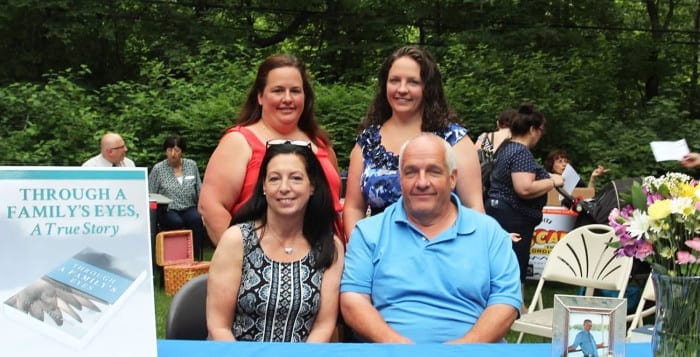By Stacy Santini
“With him it’s impossible…it’s like being with a woman. He’s so gentle. It is as though he thinks I’ll break, as though I am a piece of Dresden china and he’s gonna hurt me,” the American Film Institute’s 25th greatest female star of classic Hollywood cinema Ava Gardner was quoted saying about her marriage to the most tremendous musical icon of the 20th century, Frank Sinatra. Hailed as one of the most sensational, intense romances of all time, the bond between Gardner and Sinatra was as complex as the participants themselves.
Sal St. George and his wife Mary, of St. George Living History Productions take on the task of telling the lovers’ story in Ward Melville Heritage Organization’s Holiday Musical Theatre Performance of “Strangers in the Night … The Story of ‘The Crooner’ and the most beautiful woman in the world, Ava Gardner” currently in production through Jan. 10.
Gardner’s dreamlike pilgrimage toward stardom was what so many young girls could only hope would happen to them. The ease at which fame came upon her was not without a cost, and like many well-known 1950s leading ladies, her life was peppered with tumultuous relationships and conflicting interpersonal desires.
Raised in the Deep South, this ravishing beauty was from humble beginnings; her parents Molly and Jonas Gardner were poor cotton and tobacco farmers in Grabtown, North Carolina, a spec on the map in Johnston County. While visiting one of her four sisters, Beatrice, in New York City, her brother-in-law, Larry Tarr, a professional photographer, took some pictures of her to place in his storefront window. The images captured the eye of Loews Theatres legal clerk, Barnard Duhan, hoping to secure a date with the alluring Gardner. This interaction prompted Tarr to send her pictures to MGM. Within the blink of an eye, Gardner was solicited to do a screen test for MGM’s talent agent, Al Altman. She was immediately signed to a standard 7-year MGM contract and flown to Hollywood.
Sal St. George talks about Ava’s ascent to celebrity: “Her story is fantastic. Coming from this tiny farm town, on a fluke a man notices her at seventeen years old. She is brought to Hollywood, signed to a contract and essentially thrown to the wolves, and in a very short time she is right there, smack dab in the middle of the pack, keeping company with some of the most famous stars of all time.”
Her first fifteen movie roles for MGM were small “walk-on” parts and it appeared that it was only her beauty the studio was interested in. But in 1946, she starred opposite George Raft in “Whistle Stop” and Gardner began to carve out her place in Hollywood movie history. Playing femme fatale Kitty Collins, in Universal Studios’ adaption of Hemingway’s “The Killers” with the legendary Burt Lancaster further secured her status. Performances in “The Snows of Kilimanjaro” and “The Sun Also Rises” made it impossible to not recognize that there was indeed a tremendous talent behind the now tempered southern drawl. Although nominated for an Academy Award for her role in “The Killers,” it was her role in “The Barefoot Contessa” that gave her international acclaim.
As intrigued as the populace was by her beauty and her eventually respected talent as an actress, Gardner gained much notoriety for her romantic pursuits. Over the years, her partners — some spouses, some merely lovers — read like a who’s who of Hollywood.
Her first marriage, at the age of nineteen, was to Mickey Rooney. Lasting only one year, Gardner quickly moved on to famed bandleader and musician Artie Shaw. Eventually the union met the same fate as her marriage to Rooney, and Gardner moved on to marry Frank Sinatra. That relationship also did not last but, although Gardner had several more dalliances with men such as Ernest Hemingway and bullfighter Miguel Dominguin, it was “The Voice” that remained her one true love. Frank Sinatra dwelled deep in Gardner’s heart until she took her last breath in 1990.
Sal St. George is no stranger to the theater or legendary icons. Prior to starting his creative consulting company, St. George Living History Productions, he was a playwright for entities such as Disneyland, Sea World and Busch Gardens. Specializing in historic sites and museums, St. George is often commissioned to tell a story based on the history of a venue, such as The Vanderbilt Museum. He and his wife have also become known for their ability to translate, in fantastic ways, the lives of celebrated actors and actresses of the past — Lucille Ball, Natalie Wood, Judy Garland, Marilyn Monroe and Elizabeth Taylor, to name a few.
St. George likes to write from the women’s perspective and his stance when it comes to his scripts is often surprising and unexpected. In his own words, “It is easy to just go with the facts. When I am writing a script, I write to myself; it is instinctive and I believe if I find something interesting, others will too. I want the audience to feel like they are eavesdropping on the rich and famous.”
Producing about two shows per year along with the Edgar Allen Poe Festival, “Strangers in the Night” joins a long roster of stellar productions. St. George describes the show, “When Gloria Rocchio, president of the Ward Melville Heritage Organization, discovered it was Frank Sinatra’s 100th birthday, she wanted to do something special. She has been pivotal in bringing us on board, very supportive and encouraging. I always try to approach things from a different angle, and with this I kept thinking that behind every great man is a great woman. I wondered what it was like to be married to Frank Sinatra, and so it was Ava Gardner’s perspective that undoubtedly would make the most impact.”
St. George’s unique perspective is further developed in his choice of settings for the storyline. Actress Gail Storm’s 1957 musical TV show serves as the catalyst for this biographical tale. Along with her sidekick Rosie, they prod guest Ava Gardner to expose what it was really like to be married to the infamous Sinatra. Expect surprises along the way.
Ava Gardner’s character is played by Sara Costantino. She is joined on stage by Sarah Cronk as Gale Storm and Kim Dufrenoy as Rosie. The production most certainly tells Ava’s story, but one will not leave without understanding Sinatra’s life as well.
Ironically, Costantino, whose resemblance to Gardner is uncanny, did not know who the woman was that she is now so elegantly portraying. After much study, it is apparent that she has assumed the role with a complete understanding of this complicated woman. When asked about her part, Costantino says, “The most challenging and exciting part about playing Ava is that she had two different lives in a way … because the studio was promoting her as one thing, but deep down she felt completely different; finding the balance between the façade she put on and who she truly felt she was. I really related to this. There are things she said in her autobiography that I have said over the years. My connection with her was amazing.”
When asking St. George what his favorite part of putting on these shows is he says, “My favorite thing in the world, period, is a blank piece of paper, for everything is created from it — the Verrazano Bridge, the Mona Lisa, all the great novels … all these started with just a blank piece of paper. I get to let my imagination run wild.”
It is hard to imagine that “Strangers in the Night … The Story of ‘The Crooner’ and the most beautiful woman in the world, Ava Gardner” was ever a blank piece of paper, but nonetheless, it has been filled in quite beautifully.
The Ward Melville Heritage Organization’s Educational and Cultural Center, 97P Main St., Stony Brook, will present “Strangers in the Night” through Jan. 10 as part of its Holiday Musical Theatre Performance series. Catered by Crazy Beans Restaurant, tickets are $50 adults, $48 seniors (60 and over), $45 groups of 20 or more. For reservations, please call 631-689-5888.


















